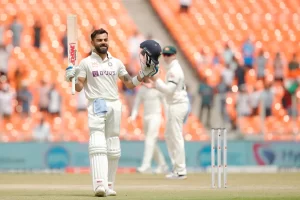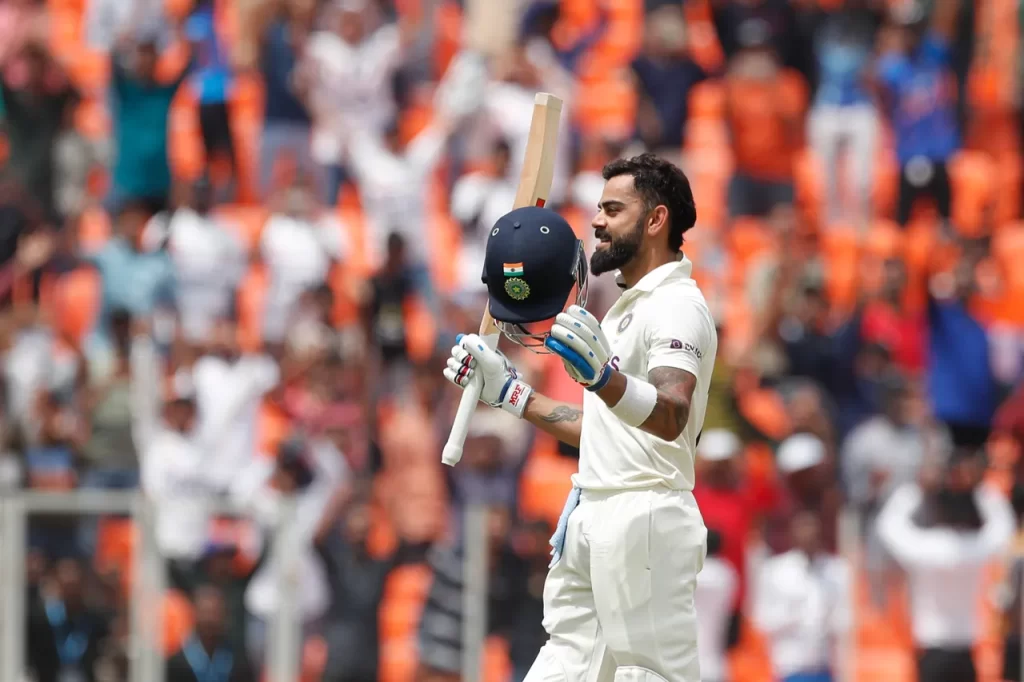
The century drought lasted 23 Tests and 41 innings, but even as the average and strike-rate plummeted, Virat Kohli’s commitment to excellence never did. Can he now gone on to enjoy the kind of Indian summer that Sachin Tendulkar and Jacques Kallis did?
The banks of the Sabarmati river in Ahmedabad have been witness to some historic moments in Indian cricket. It was there that Sunil Gavaskar became the first man to scale the 10,000-Test-run mountain. It was also the venue where India became the first team to beat Australia in a World Cup knockout game since 1996, en route to their triumph in 2011. It will now also be remembered as the ground where Virat Kohli ended a century drought that had disappointed and perplexed millions of fans in equal measure.
To understand just why there has been so much debate over Kohli’s Test form over the past three years, you have to look at the scale of his dominance before that. In his first 84 Tests (141 innings), Kohli had smashed 27 hundreds and 22 half-centuries, while averaging 54.97 and scoring at a rate of 57.81 runs per 100 balls.
As an example of how he operated in an elevated plane of his own, you only have to observe the scorecard for the day-night Test at Eden Gardens when he had scored century No:27. Kohli’s 194-ball 136 was by far the biggest score in an innings win, with Bangladesh managing totals of 106 and 195.
Kohli was 31 at the time, and there were absolutely no signs of imminent decline. His fitness levels set the standard for his teammates, and there was no hint of lesser commitment in terms of training or preparation. But then, the Covid-19 pandemic happened. Not only did it transform the way we look at life, but it also introduced cricket to ideas like bio bubbles, quarantine and isolation.
Kohli isn’t the only player who suffered, but the decline in his output was quite staggering. In his next 23 Tests (41 innings) after that Kolkata century, Kohli averaged a dismal 25.70, with the strike-rate dropping to 43. There were just six scores over 50. Another player would have been axed for such a run, but Kohli was captain, role model and had plenty of credit in the bank.
What does this hundred, on the most batting-friendly pitch seen in India in recent times, mean for Kohli and Indian cricket’s future? His fitness levels are still unmatched, and there is no discernible drop in the intensity with which he approaches every single game. The celebrations are a lot more subdued these days, but that’s more indicative of greater maturity and fatherhood than any lack of desire.
At 34, what lies ahead? What further peaks are possible? Here, a look at some of the game’s other greats might be instructive. Let’s look first at Sachin Tendulkar, whose runs (15,921) and centuries (51) records are unlikely to ever be broken. The master scored a staggering 16 centuries in 65 Tests after turning 34. Apart from England (35.78), he averaged at least 40 wherever he played, with as many as ten of those hundreds coming away from home.
But as his career wound down, there were no centuries in his final 23 games. The epic 146 at Newlands against Dale Steyn and Morne Morkel in January 2011 would be his last three-figure score in whites. Ricky Ponting, next on the all-time run-scoring list, finished stronger, with two hundreds in his final year, but the man who was a byword for ruthless runs at No.3 was plagued by inconsistency after he turned 34.
Ponting scored five centuries from 42 Tests in that period, but the average was just 39.46, a far cry from the days when he crunched out runs for fun. Perhaps, Ponting’s instinct to dominate the bowlers was his undoing. One of the other great middle-order batsmen had a much better time of it after his 34th birthday. Jacques Kallis scored 14 of his 45 hundreds in that period, with both his average (57.92) and strike-rate (53.52) well above his career numbers. Until his final year, when the average dropped to 25.75, Kallis was a central figure in a formidable South African team.
Kohli’s desire to impose his will on the bowlers once made Sir Vivian Richards say that he was the modern-day player that reminded him most of himself. But the Richards game was very much built around peerless hand-eye coordination, and once that began to deteriorate, his number dropped dramatically.
Richards made five centuries from 43 Tests after turning 34, but there were none in the last 13. And his average in those last six years was 43.80, a steep decline from what it was previously (53.74). The remarkable strike-rate (over 70) didn’t drop, but the devastating shots that once destroyed teams didn’t always find the rope or clear it.
Barring a remarkable upset from Sri Lanka’s cricketers in New Zealand, India should play in the World Test Championship final against Australia in June. In the inaugural event, in 2021, the Kohli-led India fell short against New Zealand. The existence of the competition, and the possibility of winning it and completing the set of ICC trophies in India’s cabinet, should help sharpen Kohli’s mind for the challenges ahead.
Now that the drought is over, we should expect a flood.




